Biosecurity Law of the People's Republic of China
Chapter X Supplementary Provisions
Article 85 For purposes of this Law, the following terms shall have the following meanings:
(1) "Biological factors" refer to animals, plants microorganisms, biotoxin, and other bioactive substances.
(2) "An outbreak of a major emerging infectious disease" refers to an infectious disease appearing in China for the first time, or re-appearing after having been declared eradicated, or appearing suddenly, which has caused or may cause serious damage to people's health or life, and leads to social panic to the detrimental of social stability.
(3) "An outbreak of a major emerging animal epidemic" refers to an animal epidemic appearing in China for the first time or re-appearing after having been declared eradicated, or a potential animal epidemic with high incidence or mortality appearing suddenly and spreading rapidly, which threatens or endangers the safety of the breeding industry production or may cause damage to people's health or life.
(4) "An outbreak of a major emerging plant epidemic" refers to the induction of a plant disease or pest caused by a fungus, bacterium, virus, insect, nematode, ruderal, rodent, mollusc or otherwise with serious damages to plants, appearing in China for the first time or re-appearing after having been declared eradicated, or a situation in which local pests suddenly occur on a large scale and spread rapidly, and cause serious harm to crops, forests and other plants.
(5) "Research, development and application of biotechnology" refer to such activities as scientific research as well as technological development and application by recognizing, transforming, synthesizing and using creatures through science and engineer philosophy.
(6) "Pathogenic microorganisms" refer to the microorganisms which may invade human or animals and cause infectious diseases, including virus, bacterium, fungus, rickettsias, parasites, among others.
(7) "Plant pests" refer to such creatures as Fungus, Bacterium, virus, insects, nematodes, ruderals, rodents and molluscs which may endanger crops and woods, among others.
(8) "Human genetic resources" include human genetic resource materials and information.
"Human genetic resource materials" refer to genetic materials such as organs, tissues and cells which contain human genome, gene or otherwise.
"Human genetic resource information" refers to data or other information originated from human genetic resource materials.
(9) "Microorganism resistance" refers to that microorganisms resist to antimicrobial drugs, causing the fact that antimicrobial drugs may not effectively control the infection of microorganisms.
(10) "Biological weapons" refer to the types and quantities of microbial agents, other biological agents or biotoxin which are not required for prevention, protection or other peaceful purpose or are produced from any source or by any method, including the above-mentioned biological agents or biotoxin used for weapons, equipment or vehicles designed for hostile purpose or armed conflicts.
(11) "Bioterrorism" refers to the act that, by intentionally using pathogenic microorganisms and biotoxin, among others, endangers the health of humans, animals or plants and causes social panic, so as to achieve certain political purpose .
Article 86 Biosecurity information classified as national secrets shall be managed confidentially in accordance with the Law of People's Republic of China on Guarding National Secrets and other relevant confidentiality provisions of China.
Article 87 Biosecurity activities of the Chinese People's Liberation Army and the Chinese People's Armed Police Force shall be separately regulated by the Central Military Commission under the principles provided by this Law.
Article 88 This Law shall come into force as of April 15, 2021.



